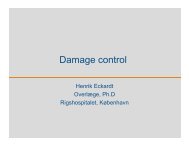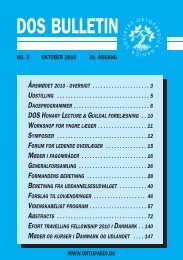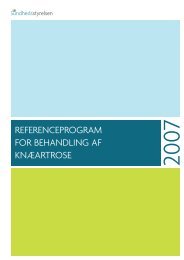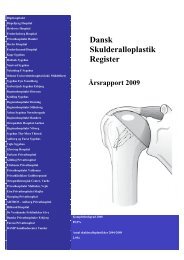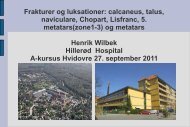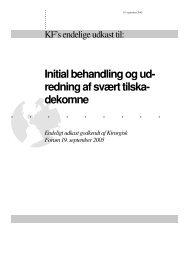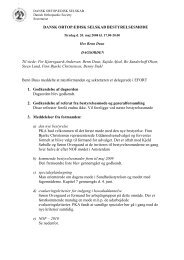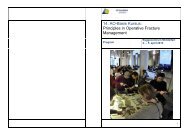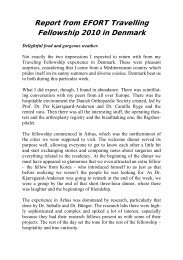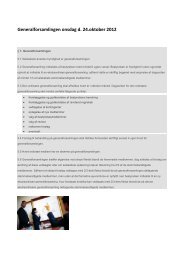You also want an ePaper? Increase the reach of your titles
YUMPU automatically turns print PDFs into web optimized ePapers that Google loves.
<strong>Olecranon</strong> <strong>fracture</strong><br />
Lonnie Froberg, MD, Ph.D<br />
Rigshospitalet, Copenhagen University Hospital
20% of forearm <strong>fracture</strong><br />
12 per 100.000 persons per year<br />
Low-energy Low energy fall<br />
Increased risk >50 years<br />
90% AO 21.B1.1<br />
Dickworth et al. Injury 2012;43:343-346<br />
2012;43:343 346
Why operate?<br />
Methods of fixation<br />
– K-wire, wire, cerklage<br />
– Plating<br />
Outcome<br />
Summary
Why operate?<br />
Restore articular surface<br />
Achieve absolute stability<br />
Commence early active movement<br />
Preservation of range of motion and<br />
power<br />
Avoidance of complications
Methods of fixation?
Methods of fixation?<br />
Cadaveric elbow joint<br />
Standard osteotomies<br />
Five different fixation<br />
techniques<br />
Loads applied comparable to<br />
clinical situations<br />
Displacements measured<br />
Fyfe et al. Jour Bone Joint Surg (Br).1985. 67B;3:367-372<br />
67B;3:367 372
Methods of fixation?<br />
Fracture type<br />
Transverse<br />
Oblique<br />
Comminuted<br />
Fixation technique<br />
Tension band 1.0 mm, 1<br />
knot, K-wire K wire 2.0 mm<br />
Tension band 1.0 mm, 2<br />
knots, K-wire K wire 2.0 mm<br />
Tubular plate<br />
Fyfe et al. Jour Bone Joint Surg (Br). 1985. 67B;3:367-372<br />
67B;3:367 372<br />
Cancellous screw, washer<br />
Cancellous screw, washer,<br />
tension band
Methods of fixation?<br />
Fracture type Fixation technique<br />
Transverse Tension band, 2 knots<br />
Oblique Tension band, 2 knots<br />
or tubular plate<br />
Comminuted Tubular plate<br />
Fyfe et al. Jour Bone Joint Surg (Br). 1985. 67B;3:367-372<br />
67B;3:367 372
K-wire wire and cerklage
How to place the K-wires? K wires?<br />
Proximal ulnar canal?<br />
Anterior cortex?<br />
Distal ulnar canal?<br />
Huang et al. J Trauma. 2010.68;1:173-176<br />
2010.68;1:173 176
How to place the K-wires? K wires?<br />
Average follow-<br />
up/months<br />
Symptomatic<br />
implant removal<br />
Proximal<br />
migration of K-<br />
wire/mm<br />
Satisfactory<br />
functionel<br />
outcome<br />
Proximal ulnar<br />
(n=24)<br />
Anterior cortex<br />
(n=28)<br />
Distal ulnar<br />
(n=26)<br />
34.5 s.d 7.2 34.0 s.d 5.9 29.6 s.d 7.2<br />
8 (33%)<br />
*p=0.03<br />
4.08 s.d. 1.89<br />
*p=0.001<br />
3 (11%) 2 (8%)<br />
1.53 s.d 0.56 1.31 s.d 0.54<br />
21 (88%) 26 (93%) 26 (100%)
How to place the K-wires? K wires?<br />
Inserted as close as possible to the<br />
articular surface<br />
Back 1 cm from final position, cut<br />
obliquely, bent<br />
Incisions with lines in triceps<br />
K-wires wires are impacted into ulna<br />
Newman et al. 2009. Injury; 40(6): 575-581 575 581
How to place the K-wires? K wires?<br />
K-wire wire penetration<br />
more than 10 mm<br />
beyond the anterior<br />
cortex increases<br />
risk for penetration<br />
of median nerve<br />
and ulnar artery<br />
Prayson et al. Shoulder Elbow Surg.<br />
2008.17;1:121-125<br />
2008.17;1:121 125
Which kind of tension band?<br />
Failure<br />
(> 2 mm movement<br />
across osteotomy)<br />
Compression<br />
Stainless steel wire 0% 71%<br />
Ethibond No. 2 100% 66%<br />
Ethibond No. 5 40% 40%<br />
Fiber wire 0% 43%<br />
Lalliss et al. Jour Bone Joint Surg (Br).2010.92B;2:315-319
Plating
Plating<br />
When to plate?<br />
– Tension band is not appropriate<br />
– Oblique <strong>fracture</strong>s distal to the<br />
midpoint of the troclear notch<br />
– Co-existing Co existing coronoid <strong>fracture</strong><br />
– Associated with Monteggia<br />
<strong>fracture</strong> dislocation<br />
Newman et al. 2009. Injury; 40(6): 575-581 575 581
Which kind of plate?<br />
Cadaveric study<br />
Comminute <strong>fracture</strong><br />
No difference in<br />
failure rate (>2 mm<br />
gap of <strong>fracture</strong>)<br />
Buijze et al. Arch Orthop Trauma<br />
Surg.2010;130:459-464<br />
Surg.2010;130:459 464
Which kind of plate?<br />
Advantage of locking compression<br />
plate to conventionel plate:<br />
– Angular and axial stability<br />
– Preserves periosteal blood supply<br />
– No toggling of unlocked screws (improves<br />
fixation in osteoporotic <strong>fracture</strong>s and<br />
comminution)
Which kind of plate?<br />
Stainless steel or titanium?<br />
More screw in proximal fragment<br />
better than fewer screws?<br />
Larger screws better than small<br />
screws?
Which kind of plate?<br />
Accumed stainless stell<br />
Synthes stainless stell<br />
Synthes titanium<br />
US Implants<br />
Zimmer
Which kind of plate?<br />
No statistical difference between<br />
maximum load and cycles survived<br />
Edwards et al. J Orthop Trauma 2011;25(5):306-311<br />
2011;25(5):306 311
Outcome – Cochrane review<br />
Short term<br />
(2-3 (2 3 years)<br />
*only plate fixation<br />
Pain 1<br />
(VAS score)<br />
Motion compared to<br />
non-affected non affected arm<br />
Radiographic<br />
evaluation<br />
Patient-rated Patient rated outcome 9.7<br />
(VAS score)<br />
Veillette et al. Orthop Clin N Am. 2008;39:229-236<br />
2008;39:229 236<br />
Long-term Long term<br />
(15-25 (15 25 years)<br />
6% severe daily<br />
symptoms<br />
Decreased supination Decreased flexion and<br />
extension<br />
(5 degrees)<br />
8% OA 5% OA<br />
1% non-union non union<br />
96% excellent or good
Summary – Tension band<br />
fixation<br />
Fracture: Transverse or<br />
oblique<br />
K-wire: wire: Anterior cortex or<br />
distal ulnar canal<br />
K-wire wire penetration:
Summary - Plating<br />
Fractures: Distal to the<br />
midpoint of the troclear<br />
notch, co-existing co existing coronoid<br />
<strong>fracture</strong>, Monteggia<br />
Locking compression plate<br />
theoretically superior to<br />
conventionel plate
Thank you
Technique
Technique
Technique



